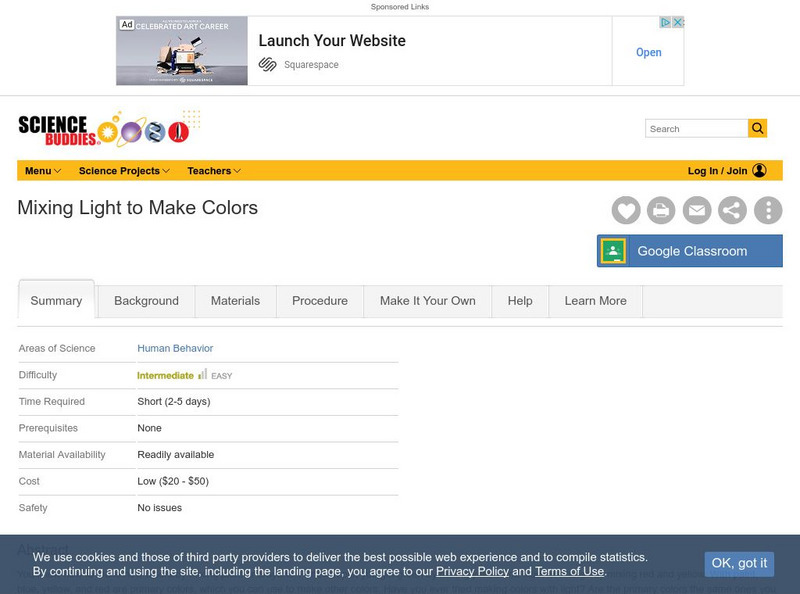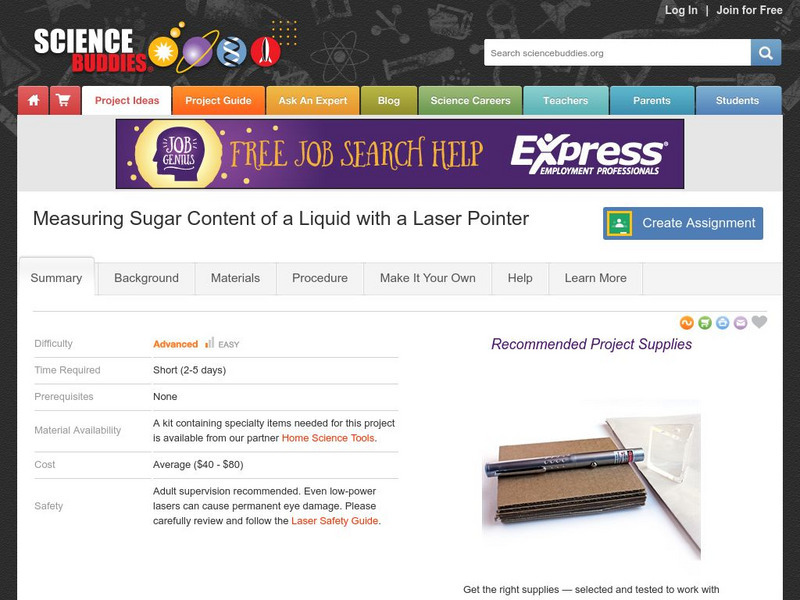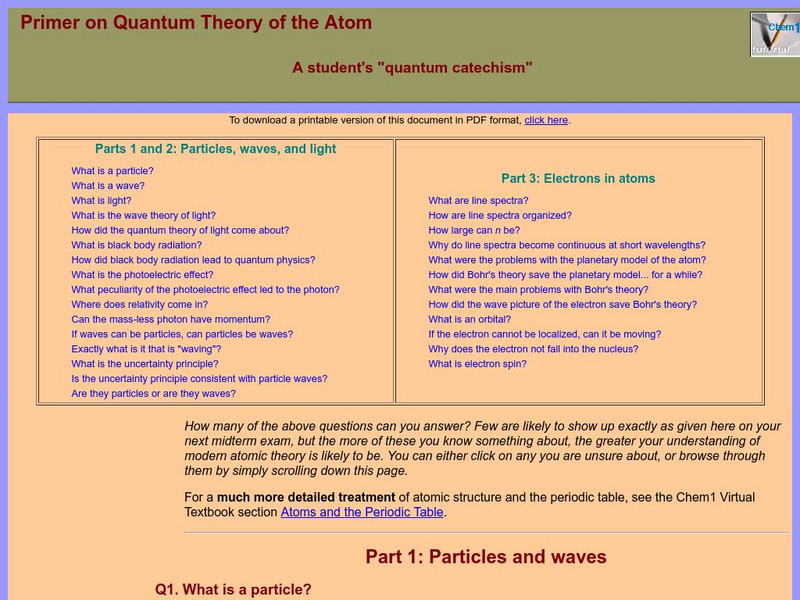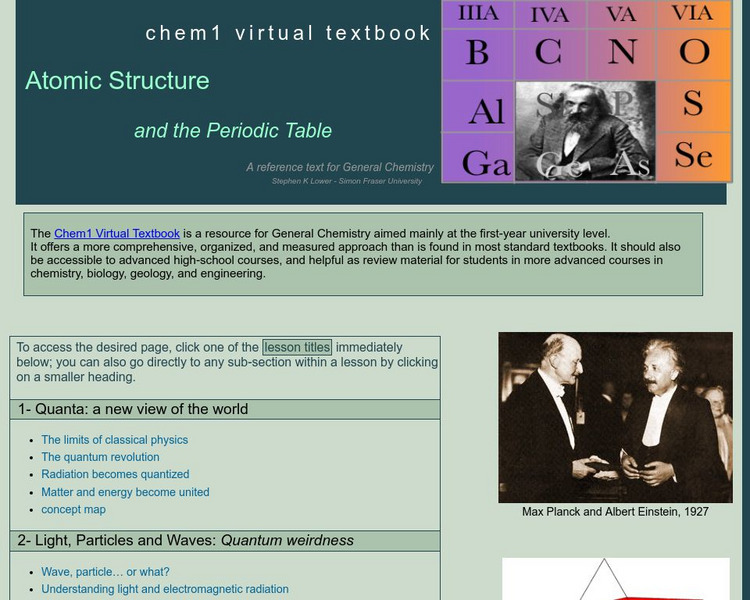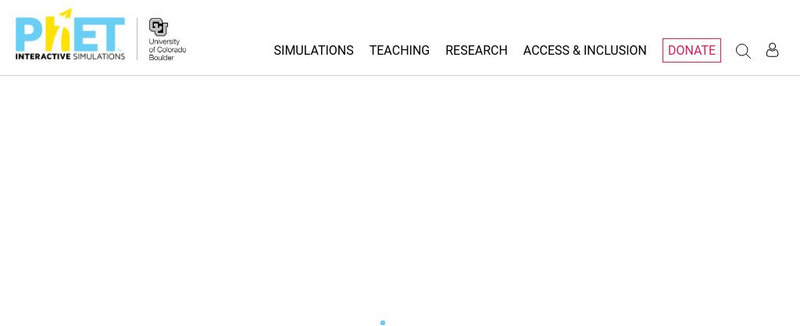PBS
Pbs Learning Media: Moths
Scientists conduct an experiment to learn about moths' attraction to light in this video segment from WILD TV. [4:10]
American Museum of Natural History
American Museum of Natural History: Ology: See the Light
Reflection, refraction, and the colors that make up white light is explored through lab activities after reading a brief background about light energy.
Science Buddies
Science Buddies: Mixing Light to Make Colors
You know how to make new colors by mixing paint or crayons. For example, you get green by mixing yellow and blue, or orange by mixing red and yellow. With paint, blue, yellow, and red are primary colors, which you can use to make other...
Science Buddies
Science Buddies: Measuring Sugar Content of a Liquid With a Laser Pointer
Here's a project that shows you how to use a laser pointer and some knowledge of physics to figure out the concentration of sugar dissolved in a liquid.
Science Buddies
Science Buddies: How Does Color Affect Heating by Absorption of Light?
Light is an example of an electromagnetic wave. Electromagnetic waves can travel through the vacuum of interstellar space. They do not depend on an external medium-unlike a mechanical wave such as a sound wave which must travel through...
Science Buddies
Science Buddies: Technicolor Shadows: Lessons in Light and Color
Is that right side of your brain yearning to express its artistic side? This is a project that blends art with science. Learn about light and colorful shadows in these experiments where you mix and match various colors of light to create...
University of Colorado
University of Colorado: Ph Et Interactive Simulations: Photoelectric Effect
See how light knocks electrons off a metal target, and recreate the experiment that spawned the field of quantum mechanics. Describe how the results lead to the photon model of light.
University of Colorado
University of Colorado: Ph Et Interactive Simulations: Neon Lights and Other Discharge Lamps
Produce light by bombarding atoms with electrons. See how the characteristic spectra of different elements are produced, and configure your own element's energy states to produce light of different colors.
University of Colorado
University of Colorado: Physics 2000: More About Visualizing Electromagnetic Waves
Discusses the nature of an electromagnetic wave. Explains the oscillating electric field and represents it through clever graphics and animations.
University of Colorado
University of Colorado: Physics 2000: Cat Scans: Projecting Shadows
This page and the three pages which follow discuss how X-ray technology can be used to produce an image of the human body. Discussion is understandable and highly intriguing. Several interactive animations allow the visitor to explore...
University of Colorado
University of Colorado: Physics 2000: Quantum Atom
Several pages with an interesting discussion of the visible light spectrum and atomic absorption and emission line spectrum. Features excellent graphics, thorough and understandable discussion, and many interactive Java applets.
University of Colorado
University of Colorado: Physics 2000: Speed of Light
Using an interesting and intriguing format, this page discusses the question of "How does one measure the speed of light." Explanation focuses on Galileo's and Roemer's efforts to obtain a reasonable value. Also discusses Heinrich...
University of Colorado
University of Colorado: Ph Et Interactive Simulations: Blackbody Spectrum
How does the blackbody spectrum of the sun compare to visible light? Learn about the blackbody spectrum of the sun, a light bulb, an oven, and the earth. Adjust the temperature to see the wavelength and intensity of the spectrum change....
Simon Fraser University
Chem1 Virtual Textbook: Primer on Quantum Theory of the Atom
Covering a range of topics related to the quantum theory of the atom, this site provides a three-part dissection of atomic theory including information on particles, waves, light, electrons, and atoms.
Simon Fraser University
Chem1 Virtual Textbook: Atoms and the Periodic Table
As part of the General Chemistry Virtual Textbook, this site examines a list of related topics (in hyperlink format) on the atom and the Periodic Table of elements. Topics from light, particles, and waves to the Bohr model, quantum...
Technology Student
Technology Student: Electronics Index
This site contains a wealth of material on electronics. Various components and techniques are thoroughly described and clearly illustrated.
BioEd Online
Bio Ed Online: How Does Light Affect Root Growth?
In this lesson for students from 3rd-12th grades will learn to build an experiment chamber to test the effects of light on Brassica rapa roots, and compare their results with outcomes from plant experiments conducted aboard the...
University of New South Wales (Australia)
University of New South Wales: School of Physics: Physclips:the Nature of Light
Physiclips thoroughly presents mechanics concepts about light with animations and film clips. Learn about light and color, wavelengths, speed of light, electromagnetic waves, Young's experiment, and photons.
University of Colorado
University of Colorado: Ph Et Interactive Simulations: Wave Interference
Make waves with a dripping faucet, audio speaker, or laser. Add a second source or a pair of slits to create an interference pattern.
University of Colorado
University of Colorado: Ph Et Interactive Simulations: Beer's Law Lab
An interactive simulation that teaches about Beer's Law, solutions, concentration, spectrophotometry, and more through observations to explore how much light is absorbed and transmitted with changes in thickness and color. This...
University of Colorado
University of Colorado: Ph Et Interactive Simulations: Blackbody Spectrum
An interactive simulation that teaches about blackbody, sun, light, and quantum mechanics. Students learn my making observations while changing the temperature with a sun, a light bulb, an oven, and the Earth in order to see the changes...
University of Colorado
University of Colorado: Ph Et Interactive Simulations: Molecules and Light
An interactive simulation that teaches about molecules, photons, and absorption by exploring how light interacts with molecules in our atmosphere. Through this simulation students can get a better understanding of the importance of the...
Kansas State
The Laser Adventure
Kansas State University site explaining all aspects of LASERS. The site is set up as an online book with clickable chapters.
PBS
Pbs Learning Media: Night Light Game
Why is light important? Play this interactive night light game with PEEP and observe why we need light to see objects. Also included are teaching tips.



